Report on Team Working and Communication for Workplace Success
VerifiedAdded on 2020/11/23
|10
|2713
|414
Report
AI Summary
This report delves into the critical aspects of team working and communication within an organizational context. It commences by defining communication and exploring its significance in teamwork, emphasizing both positive and negative impacts. The report outlines the importance of effective communication for smooth operations, highlighting its role in resolving issues, improving productivity, increasing job satisfaction, and bridging cultural gaps. It then differentiates between verbal and non-verbal communication, providing examples of their application in the workplace. Furthermore, the report examines several theories of effective communication, including communication accommodation theory, critical theory, uncertainty reduction theory, symbolic interaction theory, and organizational information theory. Each theory is explained with real-world examples, demonstrating how they can be applied to enhance communication strategies and foster a more cohesive and productive work environment. The report concludes by summarizing the key takeaways and reinforcing the importance of effective communication for organizational success.
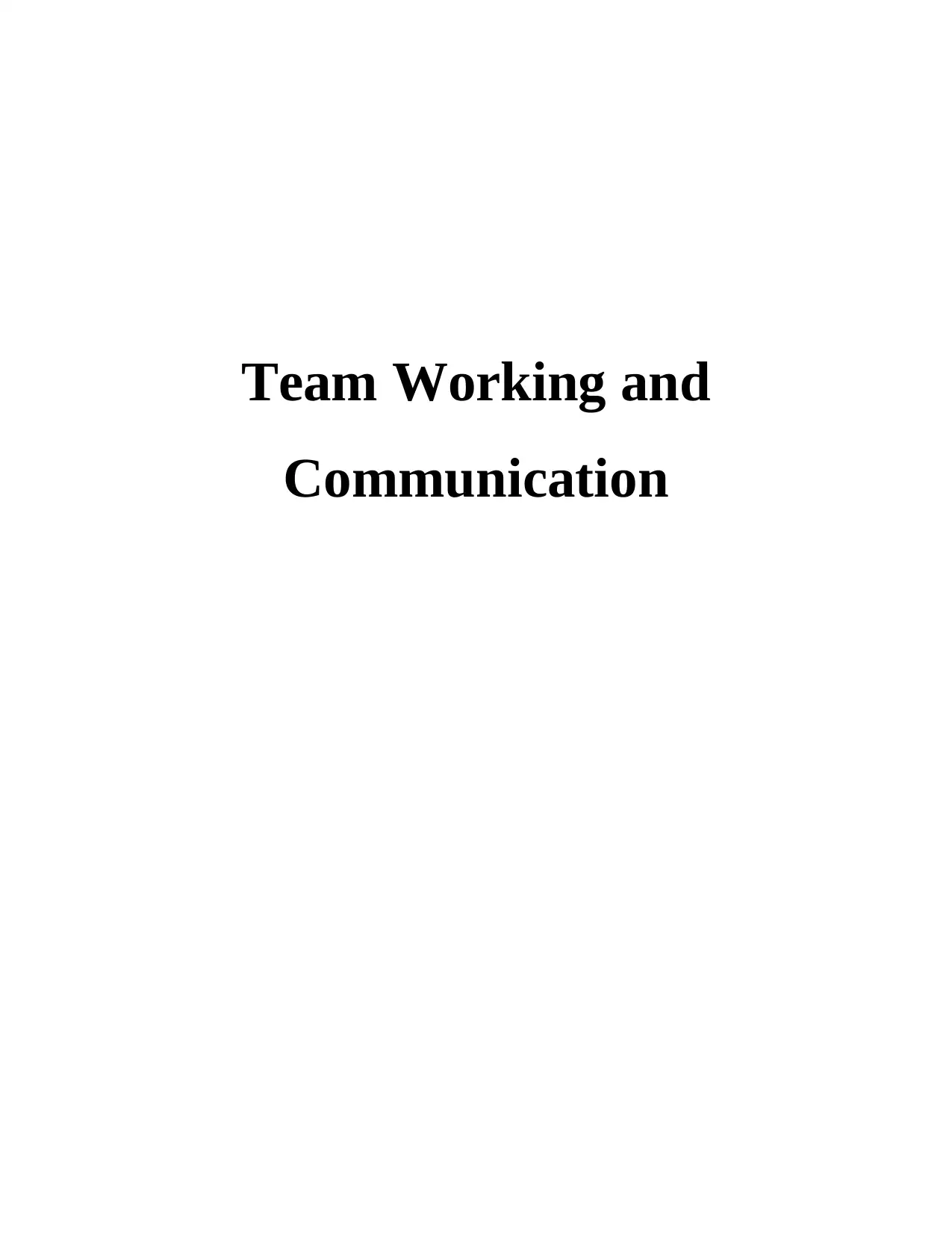
Team Working and
Communication
Communication
Paraphrase This Document
Need a fresh take? Get an instant paraphrase of this document with our AI Paraphraser
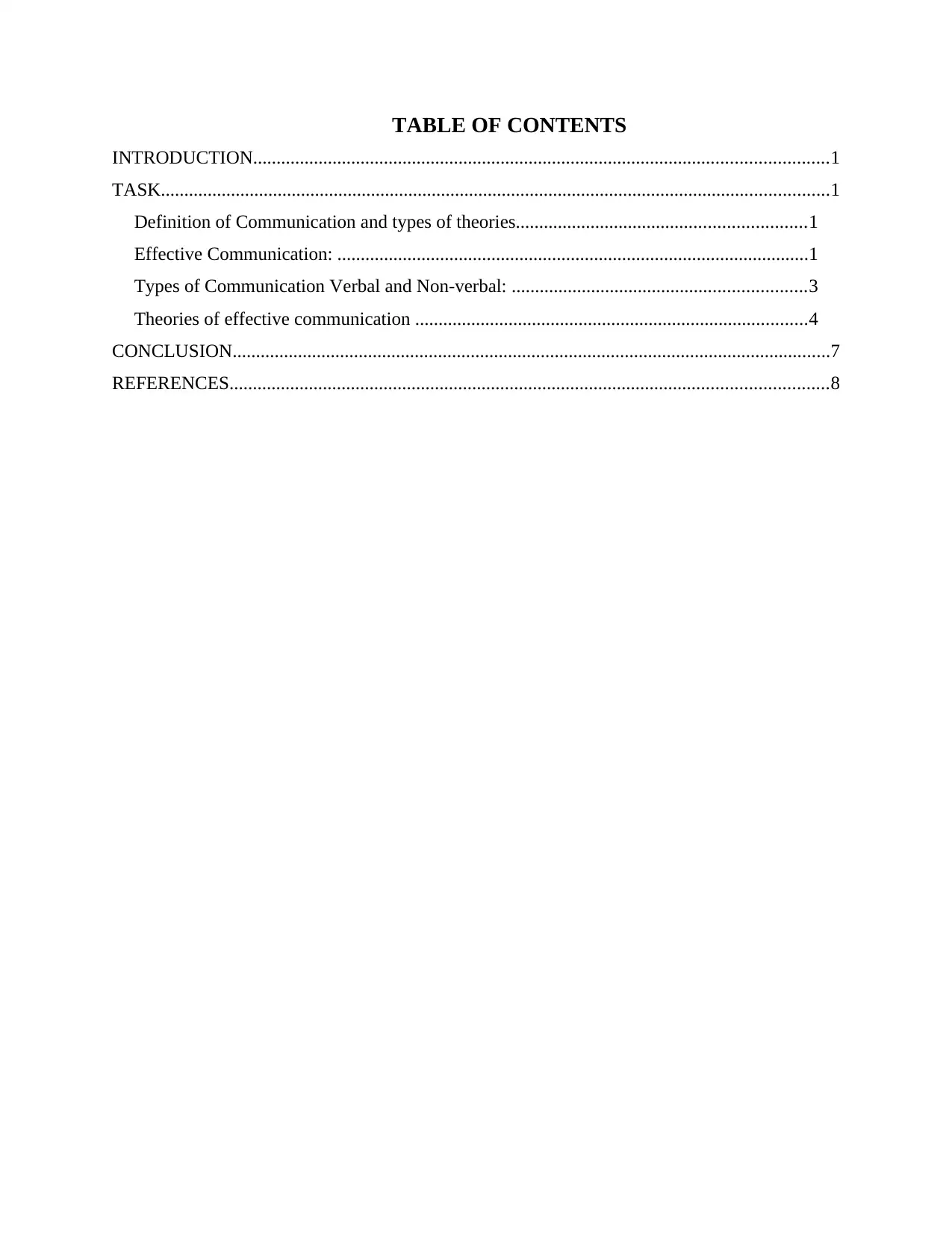
TABLE OF CONTENTS
INTRODUCTION...........................................................................................................................1
TASK...............................................................................................................................................1
Definition of Communication and types of theories..............................................................1
Effective Communication: .....................................................................................................1
Types of Communication Verbal and Non-verbal: ...............................................................3
Theories of effective communication ....................................................................................4
CONCLUSION................................................................................................................................7
REFERENCES................................................................................................................................8
INTRODUCTION...........................................................................................................................1
TASK...............................................................................................................................................1
Definition of Communication and types of theories..............................................................1
Effective Communication: .....................................................................................................1
Types of Communication Verbal and Non-verbal: ...............................................................3
Theories of effective communication ....................................................................................4
CONCLUSION................................................................................................................................7
REFERENCES................................................................................................................................8
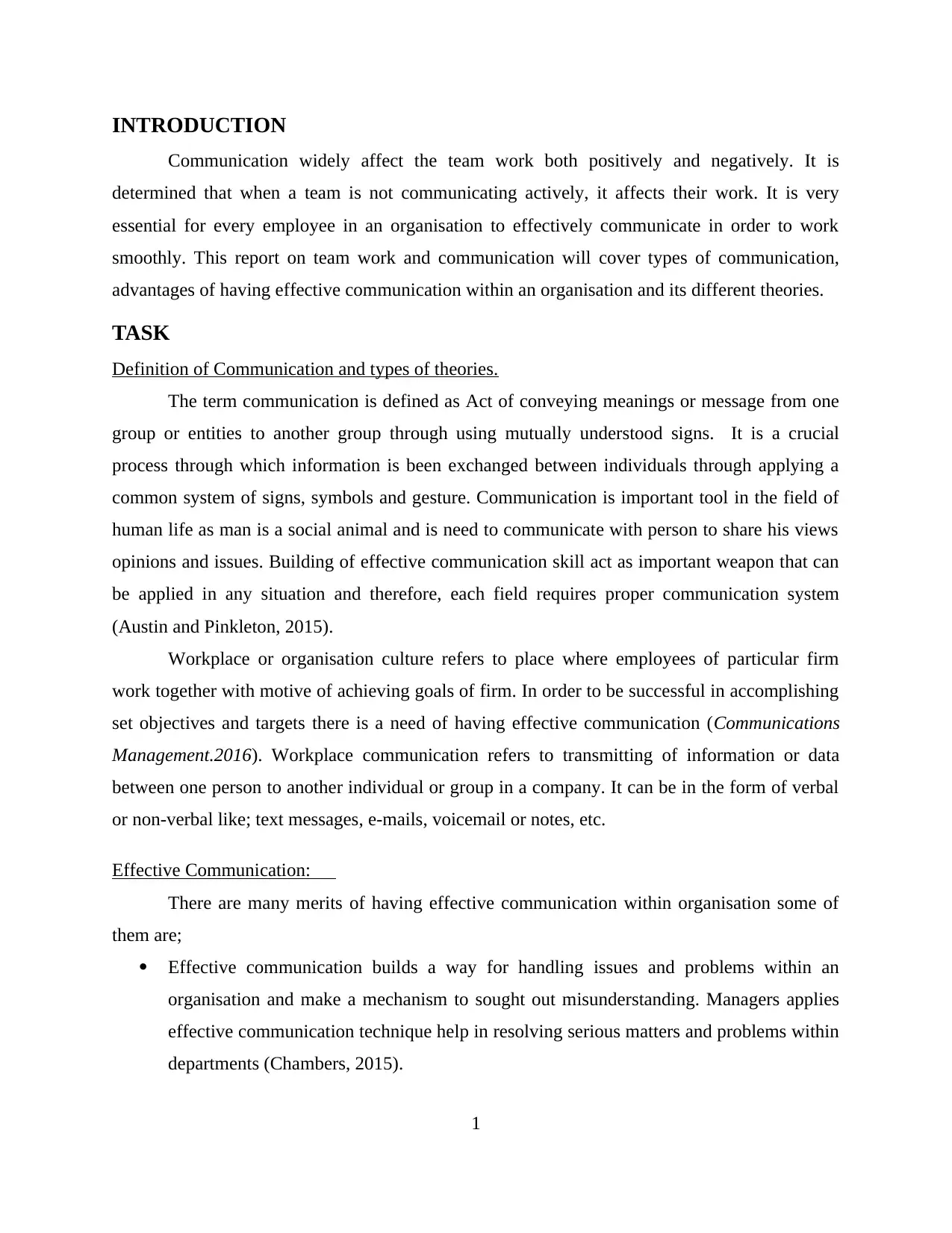
INTRODUCTION
Communication widely affect the team work both positively and negatively. It is
determined that when a team is not communicating actively, it affects their work. It is very
essential for every employee in an organisation to effectively communicate in order to work
smoothly. This report on team work and communication will cover types of communication,
advantages of having effective communication within an organisation and its different theories.
TASK
Definition of Communication and types of theories.
The term communication is defined as Act of conveying meanings or message from one
group or entities to another group through using mutually understood signs. It is a crucial
process through which information is been exchanged between individuals through applying a
common system of signs, symbols and gesture. Communication is important tool in the field of
human life as man is a social animal and is need to communicate with person to share his views
opinions and issues. Building of effective communication skill act as important weapon that can
be applied in any situation and therefore, each field requires proper communication system
(Austin and Pinkleton, 2015).
Workplace or organisation culture refers to place where employees of particular firm
work together with motive of achieving goals of firm. In order to be successful in accomplishing
set objectives and targets there is a need of having effective communication (Communications
Management.2016). Workplace communication refers to transmitting of information or data
between one person to another individual or group in a company. It can be in the form of verbal
or non-verbal like; text messages, e-mails, voicemail or notes, etc.
Effective Communication:
There are many merits of having effective communication within organisation some of
them are;
Effective communication builds a way for handling issues and problems within an
organisation and make a mechanism to sought out misunderstanding. Managers applies
effective communication technique help in resolving serious matters and problems within
departments (Chambers, 2015).
1
Communication widely affect the team work both positively and negatively. It is
determined that when a team is not communicating actively, it affects their work. It is very
essential for every employee in an organisation to effectively communicate in order to work
smoothly. This report on team work and communication will cover types of communication,
advantages of having effective communication within an organisation and its different theories.
TASK
Definition of Communication and types of theories.
The term communication is defined as Act of conveying meanings or message from one
group or entities to another group through using mutually understood signs. It is a crucial
process through which information is been exchanged between individuals through applying a
common system of signs, symbols and gesture. Communication is important tool in the field of
human life as man is a social animal and is need to communicate with person to share his views
opinions and issues. Building of effective communication skill act as important weapon that can
be applied in any situation and therefore, each field requires proper communication system
(Austin and Pinkleton, 2015).
Workplace or organisation culture refers to place where employees of particular firm
work together with motive of achieving goals of firm. In order to be successful in accomplishing
set objectives and targets there is a need of having effective communication (Communications
Management.2016). Workplace communication refers to transmitting of information or data
between one person to another individual or group in a company. It can be in the form of verbal
or non-verbal like; text messages, e-mails, voicemail or notes, etc.
Effective Communication:
There are many merits of having effective communication within organisation some of
them are;
Effective communication builds a way for handling issues and problems within an
organisation and make a mechanism to sought out misunderstanding. Managers applies
effective communication technique help in resolving serious matters and problems within
departments (Chambers, 2015).
1
⊘ This is a preview!⊘
Do you want full access?
Subscribe today to unlock all pages.

Trusted by 1+ million students worldwide
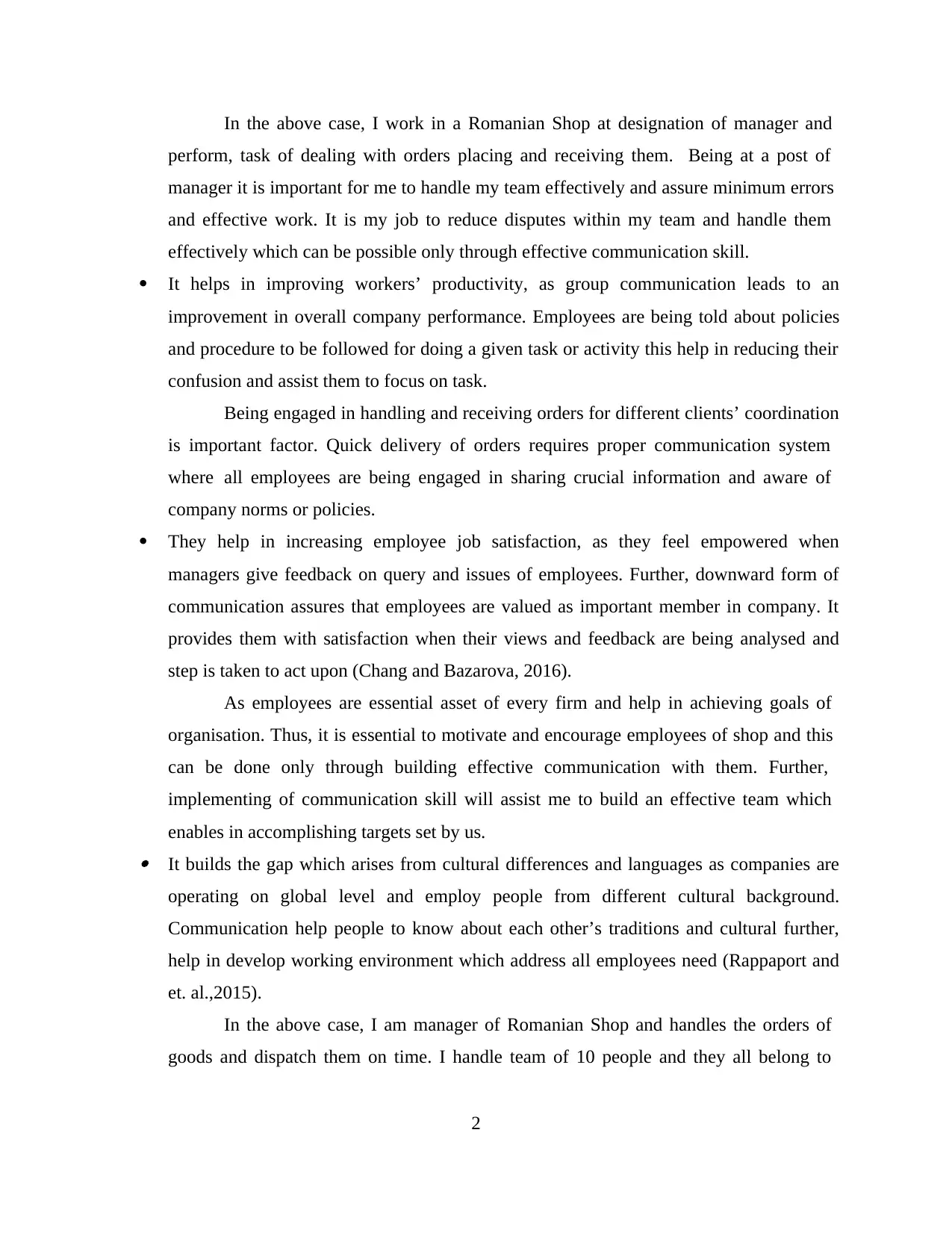
In the above case, I work in a Romanian Shop at designation of manager and
perform, task of dealing with orders placing and receiving them. Being at a post of
manager it is important for me to handle my team effectively and assure minimum errors
and effective work. It is my job to reduce disputes within my team and handle them
effectively which can be possible only through effective communication skill.
It helps in improving workers’ productivity, as group communication leads to an
improvement in overall company performance. Employees are being told about policies
and procedure to be followed for doing a given task or activity this help in reducing their
confusion and assist them to focus on task.
Being engaged in handling and receiving orders for different clients’ coordination
is important factor. Quick delivery of orders requires proper communication system
where all employees are being engaged in sharing crucial information and aware of
company norms or policies.
They help in increasing employee job satisfaction, as they feel empowered when
managers give feedback on query and issues of employees. Further, downward form of
communication assures that employees are valued as important member in company. It
provides them with satisfaction when their views and feedback are being analysed and
step is taken to act upon (Chang and Bazarova, 2016).
As employees are essential asset of every firm and help in achieving goals of
organisation. Thus, it is essential to motivate and encourage employees of shop and this
can be done only through building effective communication with them. Further,
implementing of communication skill will assist me to build an effective team which
enables in accomplishing targets set by us. It builds the gap which arises from cultural differences and languages as companies are
operating on global level and employ people from different cultural background.
Communication help people to know about each other’s traditions and cultural further,
help in develop working environment which address all employees need (Rappaport and
et. al.,2015).
In the above case, I am manager of Romanian Shop and handles the orders of
goods and dispatch them on time. I handle team of 10 people and they all belong to
2
perform, task of dealing with orders placing and receiving them. Being at a post of
manager it is important for me to handle my team effectively and assure minimum errors
and effective work. It is my job to reduce disputes within my team and handle them
effectively which can be possible only through effective communication skill.
It helps in improving workers’ productivity, as group communication leads to an
improvement in overall company performance. Employees are being told about policies
and procedure to be followed for doing a given task or activity this help in reducing their
confusion and assist them to focus on task.
Being engaged in handling and receiving orders for different clients’ coordination
is important factor. Quick delivery of orders requires proper communication system
where all employees are being engaged in sharing crucial information and aware of
company norms or policies.
They help in increasing employee job satisfaction, as they feel empowered when
managers give feedback on query and issues of employees. Further, downward form of
communication assures that employees are valued as important member in company. It
provides them with satisfaction when their views and feedback are being analysed and
step is taken to act upon (Chang and Bazarova, 2016).
As employees are essential asset of every firm and help in achieving goals of
organisation. Thus, it is essential to motivate and encourage employees of shop and this
can be done only through building effective communication with them. Further,
implementing of communication skill will assist me to build an effective team which
enables in accomplishing targets set by us. It builds the gap which arises from cultural differences and languages as companies are
operating on global level and employ people from different cultural background.
Communication help people to know about each other’s traditions and cultural further,
help in develop working environment which address all employees need (Rappaport and
et. al.,2015).
In the above case, I am manager of Romanian Shop and handles the orders of
goods and dispatch them on time. I handle team of 10 people and they all belong to
2
Paraphrase This Document
Need a fresh take? Get an instant paraphrase of this document with our AI Paraphraser
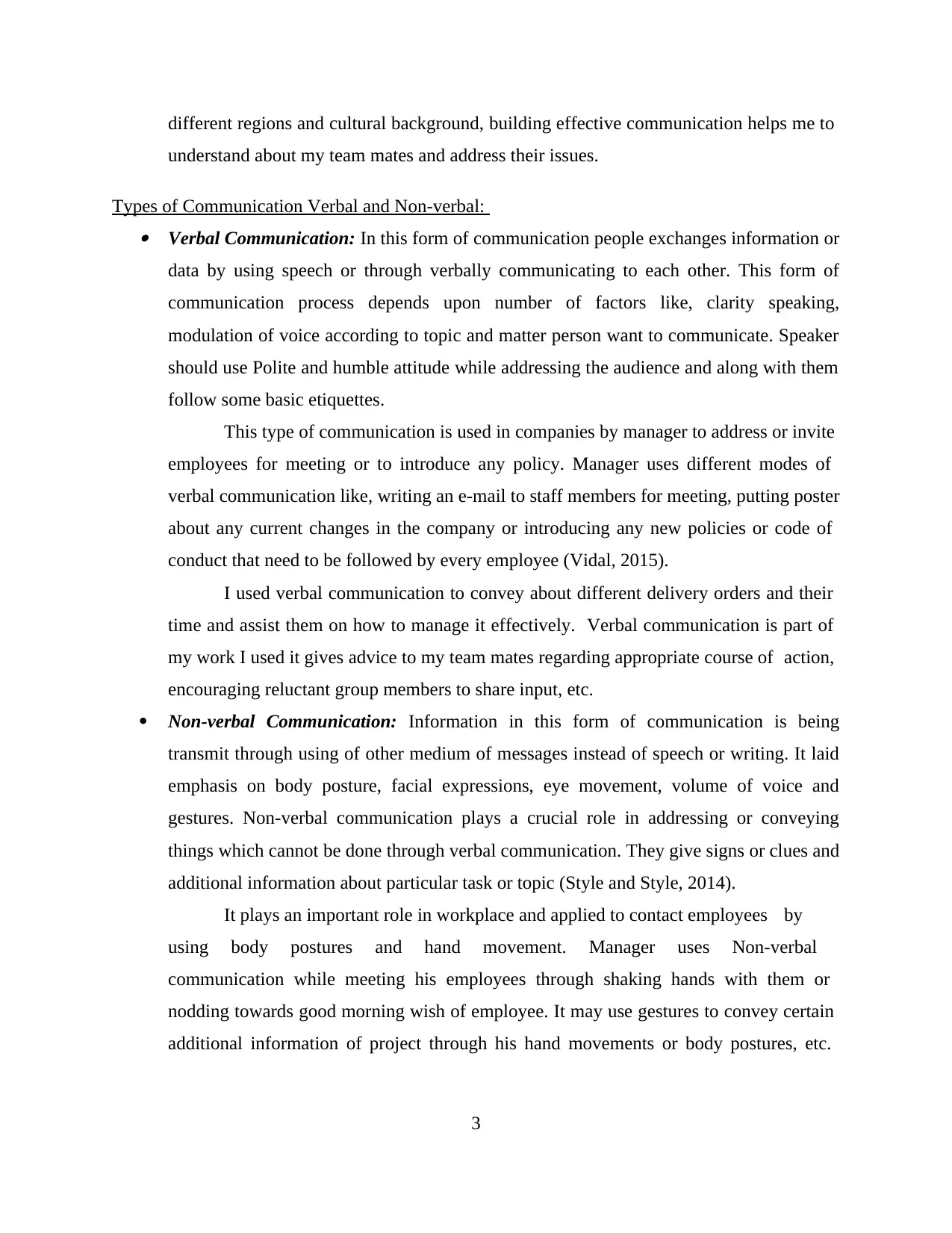
different regions and cultural background, building effective communication helps me to
understand about my team mates and address their issues.
Types of Communication Verbal and Non-verbal: Verbal Communication: In this form of communication people exchanges information or
data by using speech or through verbally communicating to each other. This form of
communication process depends upon number of factors like, clarity speaking,
modulation of voice according to topic and matter person want to communicate. Speaker
should use Polite and humble attitude while addressing the audience and along with them
follow some basic etiquettes.
This type of communication is used in companies by manager to address or invite
employees for meeting or to introduce any policy. Manager uses different modes of
verbal communication like, writing an e-mail to staff members for meeting, putting poster
about any current changes in the company or introducing any new policies or code of
conduct that need to be followed by every employee (Vidal, 2015).
I used verbal communication to convey about different delivery orders and their
time and assist them on how to manage it effectively. Verbal communication is part of
my work I used it gives advice to my team mates regarding appropriate course of action,
encouraging reluctant group members to share input, etc.
Non-verbal Communication: Information in this form of communication is being
transmit through using of other medium of messages instead of speech or writing. It laid
emphasis on body posture, facial expressions, eye movement, volume of voice and
gestures. Non-verbal communication plays a crucial role in addressing or conveying
things which cannot be done through verbal communication. They give signs or clues and
additional information about particular task or topic (Style and Style, 2014).
It plays an important role in workplace and applied to contact employees by
using body postures and hand movement. Manager uses Non-verbal
communication while meeting his employees through shaking hands with them or
nodding towards good morning wish of employee. It may use gestures to convey certain
additional information of project through his hand movements or body postures, etc.
3
understand about my team mates and address their issues.
Types of Communication Verbal and Non-verbal: Verbal Communication: In this form of communication people exchanges information or
data by using speech or through verbally communicating to each other. This form of
communication process depends upon number of factors like, clarity speaking,
modulation of voice according to topic and matter person want to communicate. Speaker
should use Polite and humble attitude while addressing the audience and along with them
follow some basic etiquettes.
This type of communication is used in companies by manager to address or invite
employees for meeting or to introduce any policy. Manager uses different modes of
verbal communication like, writing an e-mail to staff members for meeting, putting poster
about any current changes in the company or introducing any new policies or code of
conduct that need to be followed by every employee (Vidal, 2015).
I used verbal communication to convey about different delivery orders and their
time and assist them on how to manage it effectively. Verbal communication is part of
my work I used it gives advice to my team mates regarding appropriate course of action,
encouraging reluctant group members to share input, etc.
Non-verbal Communication: Information in this form of communication is being
transmit through using of other medium of messages instead of speech or writing. It laid
emphasis on body posture, facial expressions, eye movement, volume of voice and
gestures. Non-verbal communication plays a crucial role in addressing or conveying
things which cannot be done through verbal communication. They give signs or clues and
additional information about particular task or topic (Style and Style, 2014).
It plays an important role in workplace and applied to contact employees by
using body postures and hand movement. Manager uses Non-verbal
communication while meeting his employees through shaking hands with them or
nodding towards good morning wish of employee. It may use gestures to convey certain
additional information of project through his hand movements or body postures, etc.
3
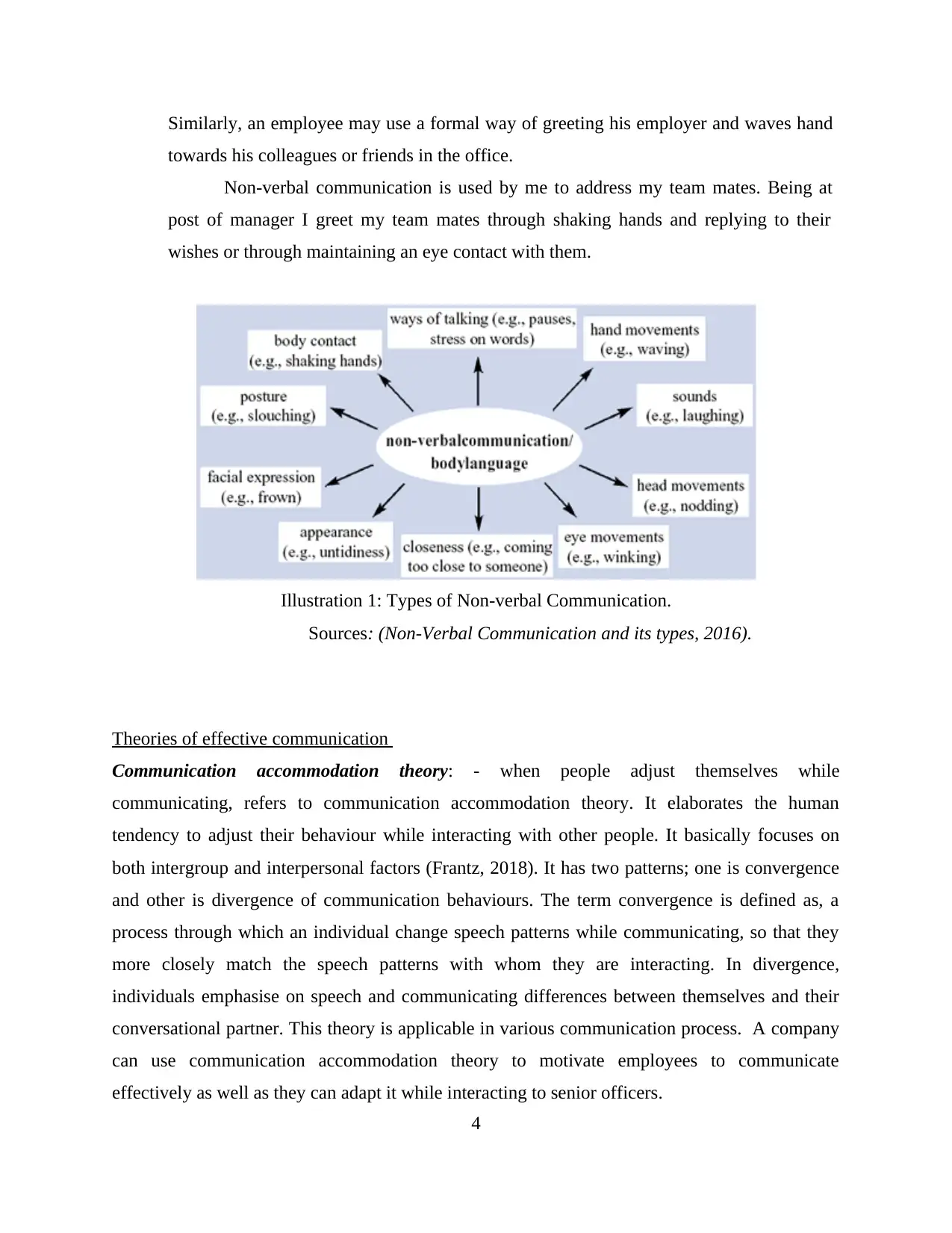
Similarly, an employee may use a formal way of greeting his employer and waves hand
towards his colleagues or friends in the office.
Non-verbal communication is used by me to address my team mates. Being at
post of manager I greet my team mates through shaking hands and replying to their
wishes or through maintaining an eye contact with them.
Illustration 1: Types of Non-verbal Communication.
Sources: (Non-Verbal Communication and its types, 2016).
Theories of effective communication
Communication accommodation theory: - when people adjust themselves while
communicating, refers to communication accommodation theory. It elaborates the human
tendency to adjust their behaviour while interacting with other people. It basically focuses on
both intergroup and interpersonal factors (Frantz, 2018). It has two patterns; one is convergence
and other is divergence of communication behaviours. The term convergence is defined as, a
process through which an individual change speech patterns while communicating, so that they
more closely match the speech patterns with whom they are interacting. In divergence,
individuals emphasise on speech and communicating differences between themselves and their
conversational partner. This theory is applicable in various communication process. A company
can use communication accommodation theory to motivate employees to communicate
effectively as well as they can adapt it while interacting to senior officers.
4
towards his colleagues or friends in the office.
Non-verbal communication is used by me to address my team mates. Being at
post of manager I greet my team mates through shaking hands and replying to their
wishes or through maintaining an eye contact with them.
Illustration 1: Types of Non-verbal Communication.
Sources: (Non-Verbal Communication and its types, 2016).
Theories of effective communication
Communication accommodation theory: - when people adjust themselves while
communicating, refers to communication accommodation theory. It elaborates the human
tendency to adjust their behaviour while interacting with other people. It basically focuses on
both intergroup and interpersonal factors (Frantz, 2018). It has two patterns; one is convergence
and other is divergence of communication behaviours. The term convergence is defined as, a
process through which an individual change speech patterns while communicating, so that they
more closely match the speech patterns with whom they are interacting. In divergence,
individuals emphasise on speech and communicating differences between themselves and their
conversational partner. This theory is applicable in various communication process. A company
can use communication accommodation theory to motivate employees to communicate
effectively as well as they can adapt it while interacting to senior officers.
4
⊘ This is a preview!⊘
Do you want full access?
Subscribe today to unlock all pages.

Trusted by 1+ million students worldwide
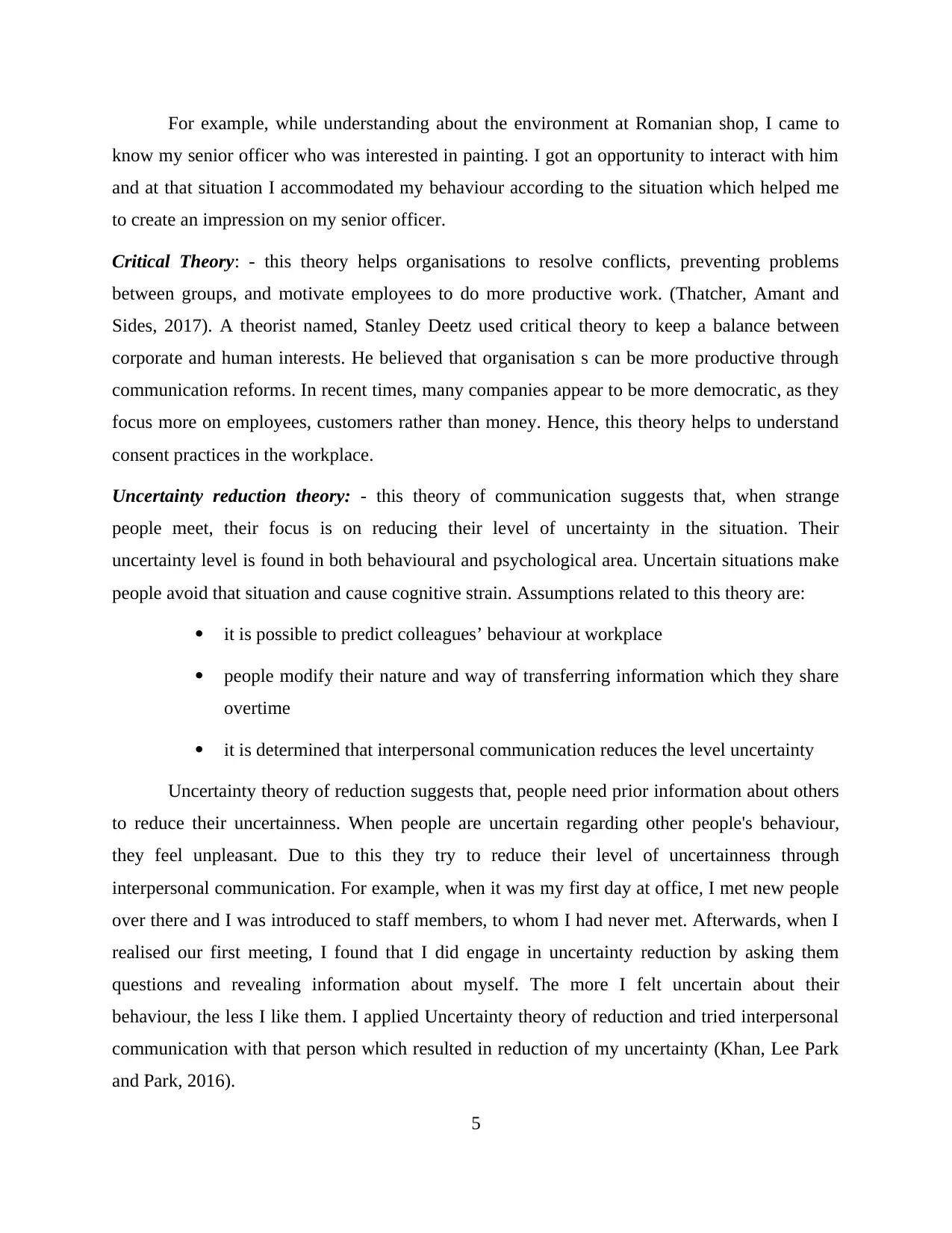
For example, while understanding about the environment at Romanian shop, I came to
know my senior officer who was interested in painting. I got an opportunity to interact with him
and at that situation I accommodated my behaviour according to the situation which helped me
to create an impression on my senior officer.
Critical Theory: - this theory helps organisations to resolve conflicts, preventing problems
between groups, and motivate employees to do more productive work. (Thatcher, Amant and
Sides, 2017). A theorist named, Stanley Deetz used critical theory to keep a balance between
corporate and human interests. He believed that organisation s can be more productive through
communication reforms. In recent times, many companies appear to be more democratic, as they
focus more on employees, customers rather than money. Hence, this theory helps to understand
consent practices in the workplace.
Uncertainty reduction theory: - this theory of communication suggests that, when strange
people meet, their focus is on reducing their level of uncertainty in the situation. Their
uncertainty level is found in both behavioural and psychological area. Uncertain situations make
people avoid that situation and cause cognitive strain. Assumptions related to this theory are:
it is possible to predict colleagues’ behaviour at workplace
people modify their nature and way of transferring information which they share
overtime
it is determined that interpersonal communication reduces the level uncertainty
Uncertainty theory of reduction suggests that, people need prior information about others
to reduce their uncertainness. When people are uncertain regarding other people's behaviour,
they feel unpleasant. Due to this they try to reduce their level of uncertainness through
interpersonal communication. For example, when it was my first day at office, I met new people
over there and I was introduced to staff members, to whom I had never met. Afterwards, when I
realised our first meeting, I found that I did engage in uncertainty reduction by asking them
questions and revealing information about myself. The more I felt uncertain about their
behaviour, the less I like them. I applied Uncertainty theory of reduction and tried interpersonal
communication with that person which resulted in reduction of my uncertainty (Khan, Lee Park
and Park, 2016).
5
know my senior officer who was interested in painting. I got an opportunity to interact with him
and at that situation I accommodated my behaviour according to the situation which helped me
to create an impression on my senior officer.
Critical Theory: - this theory helps organisations to resolve conflicts, preventing problems
between groups, and motivate employees to do more productive work. (Thatcher, Amant and
Sides, 2017). A theorist named, Stanley Deetz used critical theory to keep a balance between
corporate and human interests. He believed that organisation s can be more productive through
communication reforms. In recent times, many companies appear to be more democratic, as they
focus more on employees, customers rather than money. Hence, this theory helps to understand
consent practices in the workplace.
Uncertainty reduction theory: - this theory of communication suggests that, when strange
people meet, their focus is on reducing their level of uncertainty in the situation. Their
uncertainty level is found in both behavioural and psychological area. Uncertain situations make
people avoid that situation and cause cognitive strain. Assumptions related to this theory are:
it is possible to predict colleagues’ behaviour at workplace
people modify their nature and way of transferring information which they share
overtime
it is determined that interpersonal communication reduces the level uncertainty
Uncertainty theory of reduction suggests that, people need prior information about others
to reduce their uncertainness. When people are uncertain regarding other people's behaviour,
they feel unpleasant. Due to this they try to reduce their level of uncertainness through
interpersonal communication. For example, when it was my first day at office, I met new people
over there and I was introduced to staff members, to whom I had never met. Afterwards, when I
realised our first meeting, I found that I did engage in uncertainty reduction by asking them
questions and revealing information about myself. The more I felt uncertain about their
behaviour, the less I like them. I applied Uncertainty theory of reduction and tried interpersonal
communication with that person which resulted in reduction of my uncertainty (Khan, Lee Park
and Park, 2016).
5
Paraphrase This Document
Need a fresh take? Get an instant paraphrase of this document with our AI Paraphraser
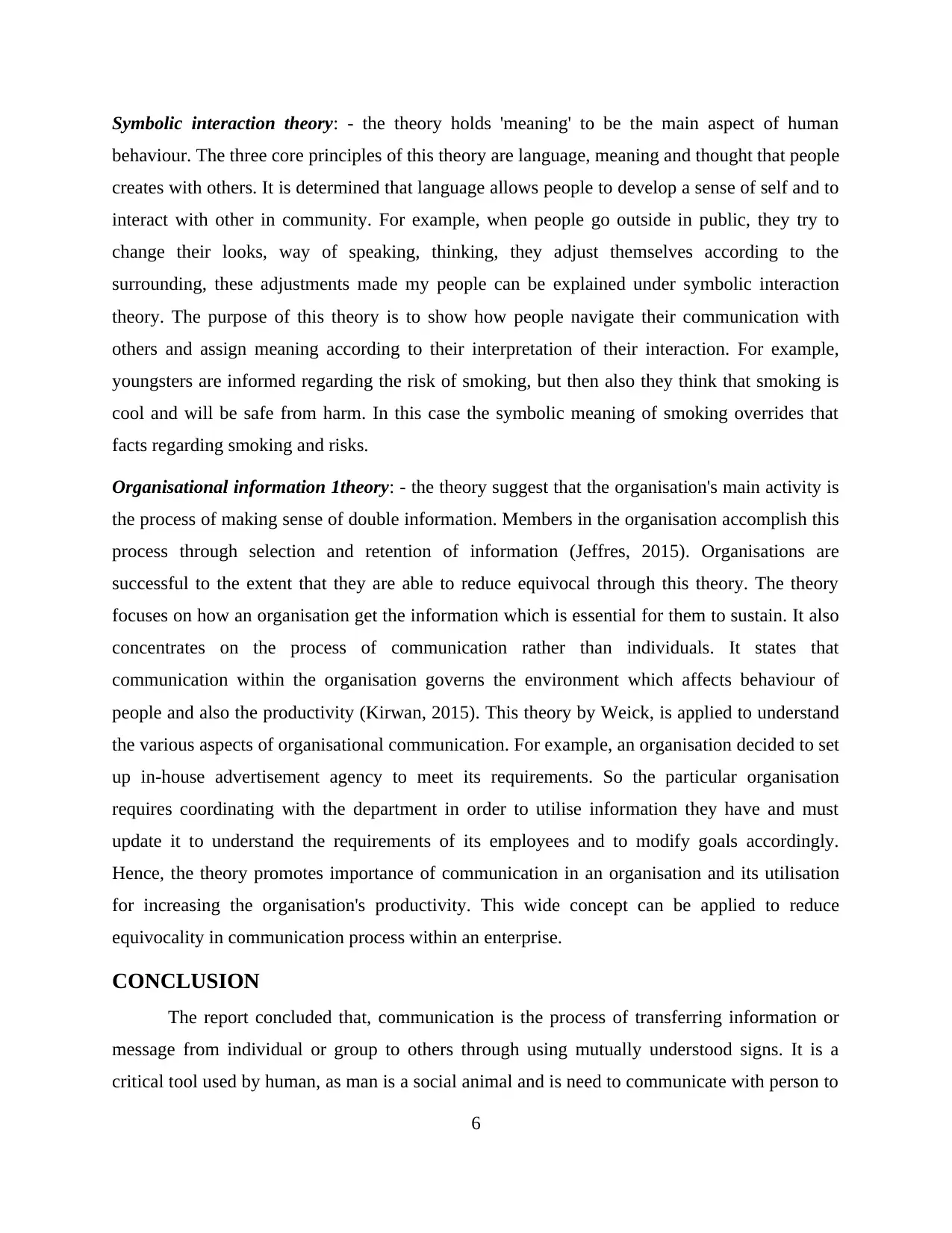
Symbolic interaction theory: - the theory holds 'meaning' to be the main aspect of human
behaviour. The three core principles of this theory are language, meaning and thought that people
creates with others. It is determined that language allows people to develop a sense of self and to
interact with other in community. For example, when people go outside in public, they try to
change their looks, way of speaking, thinking, they adjust themselves according to the
surrounding, these adjustments made my people can be explained under symbolic interaction
theory. The purpose of this theory is to show how people navigate their communication with
others and assign meaning according to their interpretation of their interaction. For example,
youngsters are informed regarding the risk of smoking, but then also they think that smoking is
cool and will be safe from harm. In this case the symbolic meaning of smoking overrides that
facts regarding smoking and risks.
Organisational information 1theory: - the theory suggest that the organisation's main activity is
the process of making sense of double information. Members in the organisation accomplish this
process through selection and retention of information (Jeffres, 2015). Organisations are
successful to the extent that they are able to reduce equivocal through this theory. The theory
focuses on how an organisation get the information which is essential for them to sustain. It also
concentrates on the process of communication rather than individuals. It states that
communication within the organisation governs the environment which affects behaviour of
people and also the productivity (Kirwan, 2015). This theory by Weick, is applied to understand
the various aspects of organisational communication. For example, an organisation decided to set
up in-house advertisement agency to meet its requirements. So the particular organisation
requires coordinating with the department in order to utilise information they have and must
update it to understand the requirements of its employees and to modify goals accordingly.
Hence, the theory promotes importance of communication in an organisation and its utilisation
for increasing the organisation's productivity. This wide concept can be applied to reduce
equivocality in communication process within an enterprise.
CONCLUSION
The report concluded that, communication is the process of transferring information or
message from individual or group to others through using mutually understood signs. It is a
critical tool used by human, as man is a social animal and is need to communicate with person to
6
behaviour. The three core principles of this theory are language, meaning and thought that people
creates with others. It is determined that language allows people to develop a sense of self and to
interact with other in community. For example, when people go outside in public, they try to
change their looks, way of speaking, thinking, they adjust themselves according to the
surrounding, these adjustments made my people can be explained under symbolic interaction
theory. The purpose of this theory is to show how people navigate their communication with
others and assign meaning according to their interpretation of their interaction. For example,
youngsters are informed regarding the risk of smoking, but then also they think that smoking is
cool and will be safe from harm. In this case the symbolic meaning of smoking overrides that
facts regarding smoking and risks.
Organisational information 1theory: - the theory suggest that the organisation's main activity is
the process of making sense of double information. Members in the organisation accomplish this
process through selection and retention of information (Jeffres, 2015). Organisations are
successful to the extent that they are able to reduce equivocal through this theory. The theory
focuses on how an organisation get the information which is essential for them to sustain. It also
concentrates on the process of communication rather than individuals. It states that
communication within the organisation governs the environment which affects behaviour of
people and also the productivity (Kirwan, 2015). This theory by Weick, is applied to understand
the various aspects of organisational communication. For example, an organisation decided to set
up in-house advertisement agency to meet its requirements. So the particular organisation
requires coordinating with the department in order to utilise information they have and must
update it to understand the requirements of its employees and to modify goals accordingly.
Hence, the theory promotes importance of communication in an organisation and its utilisation
for increasing the organisation's productivity. This wide concept can be applied to reduce
equivocality in communication process within an enterprise.
CONCLUSION
The report concluded that, communication is the process of transferring information or
message from individual or group to others through using mutually understood signs. It is a
critical tool used by human, as man is a social animal and is need to communicate with person to
6
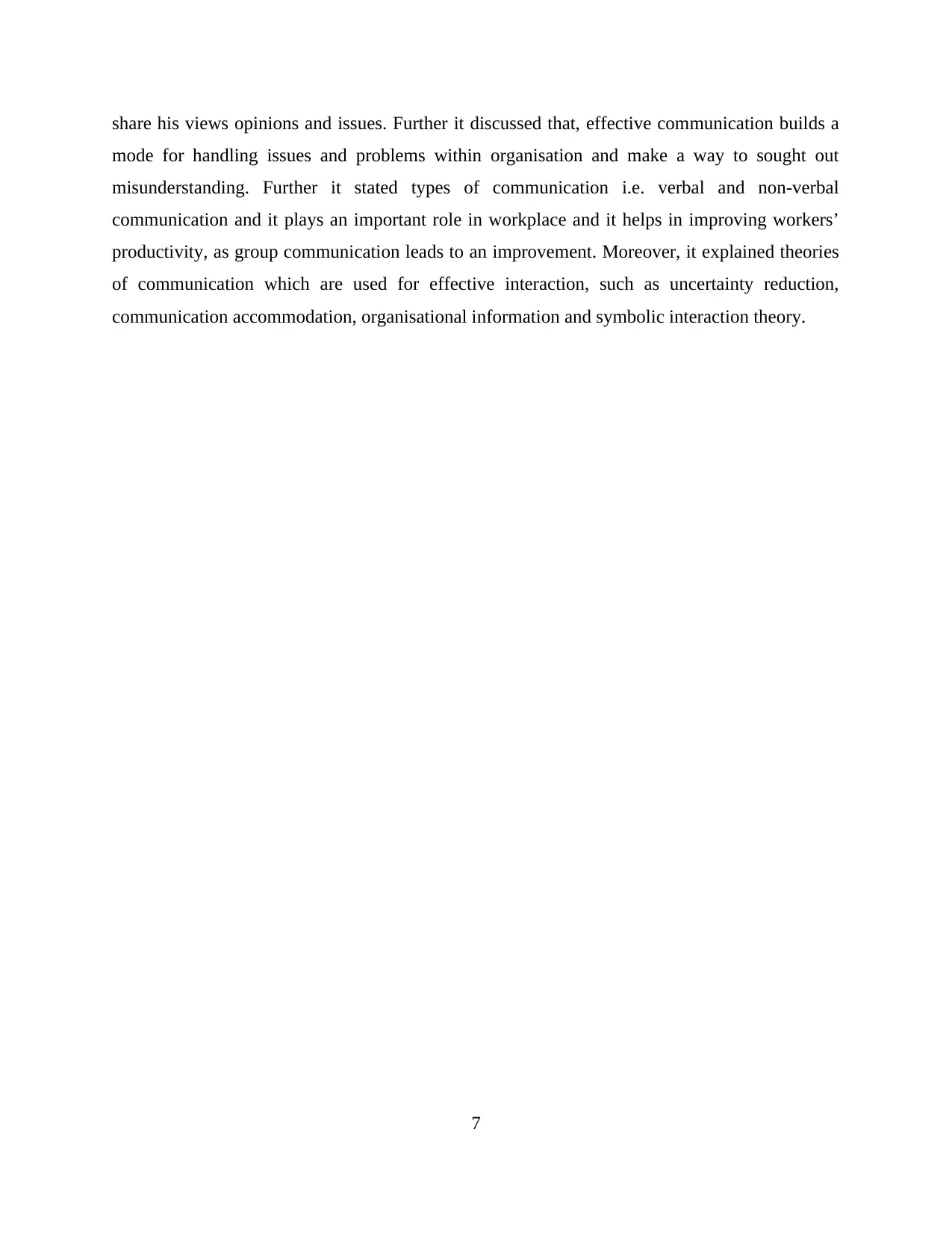
share his views opinions and issues. Further it discussed that, effective communication builds a
mode for handling issues and problems within organisation and make a way to sought out
misunderstanding. Further it stated types of communication i.e. verbal and non-verbal
communication and it plays an important role in workplace and it helps in improving workers’
productivity, as group communication leads to an improvement. Moreover, it explained theories
of communication which are used for effective interaction, such as uncertainty reduction,
communication accommodation, organisational information and symbolic interaction theory.
7
mode for handling issues and problems within organisation and make a way to sought out
misunderstanding. Further it stated types of communication i.e. verbal and non-verbal
communication and it plays an important role in workplace and it helps in improving workers’
productivity, as group communication leads to an improvement. Moreover, it explained theories
of communication which are used for effective interaction, such as uncertainty reduction,
communication accommodation, organisational information and symbolic interaction theory.
7
⊘ This is a preview!⊘
Do you want full access?
Subscribe today to unlock all pages.

Trusted by 1+ million students worldwide
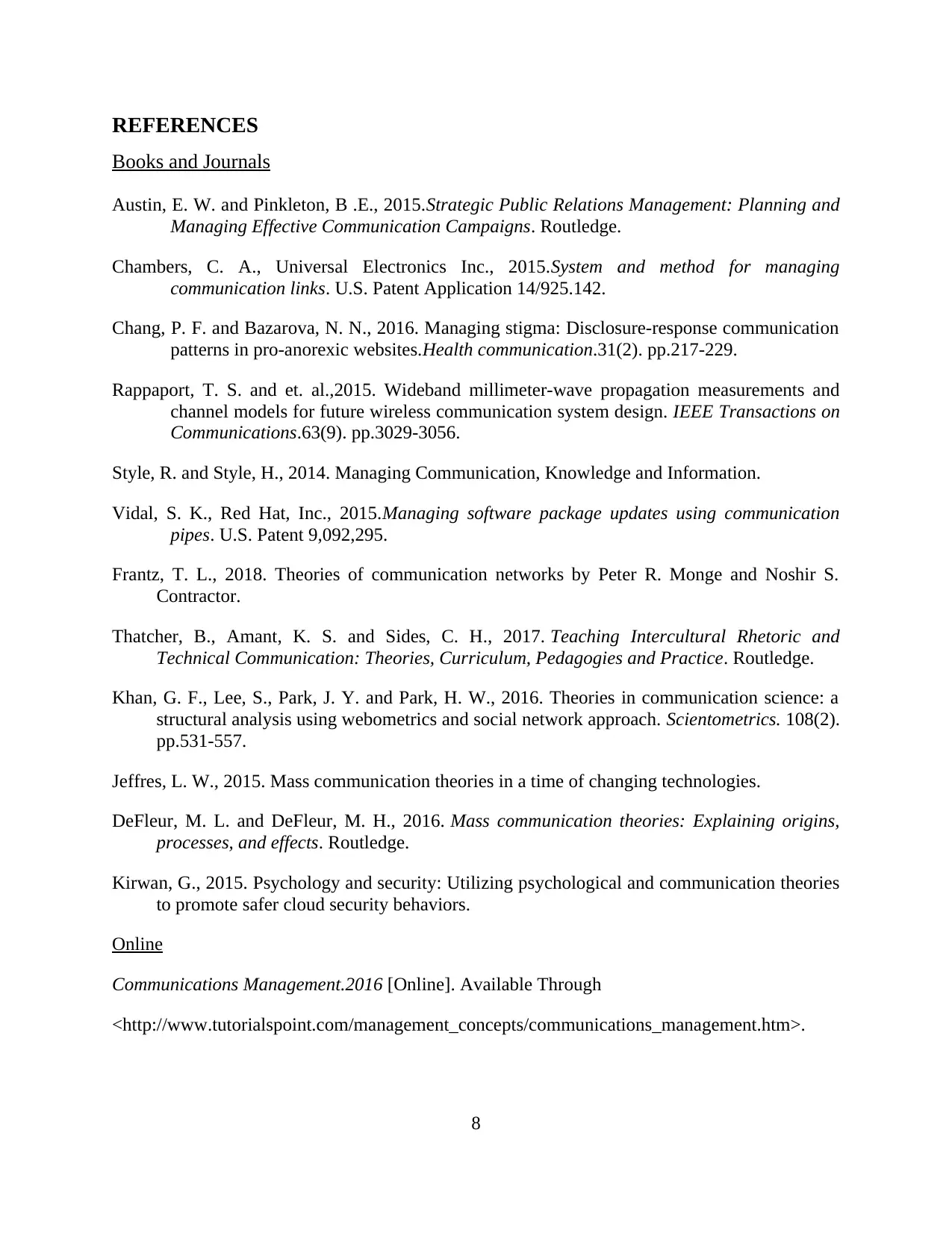
REFERENCES
Books and Journals
Austin, E. W. and Pinkleton, B .E., 2015.Strategic Public Relations Management: Planning and
Managing Effective Communication Campaigns. Routledge.
Chambers, C. A., Universal Electronics Inc., 2015.System and method for managing
communication links. U.S. Patent Application 14/925.142.
Chang, P. F. and Bazarova, N. N., 2016. Managing stigma: Disclosure-response communication
patterns in pro-anorexic websites.Health communication.31(2). pp.217-229.
Rappaport, T. S. and et. al.,2015. Wideband millimeter-wave propagation measurements and
channel models for future wireless communication system design. IEEE Transactions on
Communications.63(9). pp.3029-3056.
Style, R. and Style, H., 2014. Managing Communication, Knowledge and Information.
Vidal, S. K., Red Hat, Inc., 2015.Managing software package updates using communication
pipes. U.S. Patent 9,092,295.
Frantz, T. L., 2018. Theories of communication networks by Peter R. Monge and Noshir S.
Contractor.
Thatcher, B., Amant, K. S. and Sides, C. H., 2017. Teaching Intercultural Rhetoric and
Technical Communication: Theories, Curriculum, Pedagogies and Practice. Routledge.
Khan, G. F., Lee, S., Park, J. Y. and Park, H. W., 2016. Theories in communication science: a
structural analysis using webometrics and social network approach. Scientometrics. 108(2).
pp.531-557.
Jeffres, L. W., 2015. Mass communication theories in a time of changing technologies.
DeFleur, M. L. and DeFleur, M. H., 2016. Mass communication theories: Explaining origins,
processes, and effects. Routledge.
Kirwan, G., 2015. Psychology and security: Utilizing psychological and communication theories
to promote safer cloud security behaviors.
Online
Communications Management.2016 [Online]. Available Through
<http://www.tutorialspoint.com/management_concepts/communications_management.htm>.
8
Books and Journals
Austin, E. W. and Pinkleton, B .E., 2015.Strategic Public Relations Management: Planning and
Managing Effective Communication Campaigns. Routledge.
Chambers, C. A., Universal Electronics Inc., 2015.System and method for managing
communication links. U.S. Patent Application 14/925.142.
Chang, P. F. and Bazarova, N. N., 2016. Managing stigma: Disclosure-response communication
patterns in pro-anorexic websites.Health communication.31(2). pp.217-229.
Rappaport, T. S. and et. al.,2015. Wideband millimeter-wave propagation measurements and
channel models for future wireless communication system design. IEEE Transactions on
Communications.63(9). pp.3029-3056.
Style, R. and Style, H., 2014. Managing Communication, Knowledge and Information.
Vidal, S. K., Red Hat, Inc., 2015.Managing software package updates using communication
pipes. U.S. Patent 9,092,295.
Frantz, T. L., 2018. Theories of communication networks by Peter R. Monge and Noshir S.
Contractor.
Thatcher, B., Amant, K. S. and Sides, C. H., 2017. Teaching Intercultural Rhetoric and
Technical Communication: Theories, Curriculum, Pedagogies and Practice. Routledge.
Khan, G. F., Lee, S., Park, J. Y. and Park, H. W., 2016. Theories in communication science: a
structural analysis using webometrics and social network approach. Scientometrics. 108(2).
pp.531-557.
Jeffres, L. W., 2015. Mass communication theories in a time of changing technologies.
DeFleur, M. L. and DeFleur, M. H., 2016. Mass communication theories: Explaining origins,
processes, and effects. Routledge.
Kirwan, G., 2015. Psychology and security: Utilizing psychological and communication theories
to promote safer cloud security behaviors.
Online
Communications Management.2016 [Online]. Available Through
<http://www.tutorialspoint.com/management_concepts/communications_management.htm>.
8
1 out of 10
Related Documents
Your All-in-One AI-Powered Toolkit for Academic Success.
+13062052269
info@desklib.com
Available 24*7 on WhatsApp / Email
![[object Object]](/_next/static/media/star-bottom.7253800d.svg)
Unlock your academic potential
Copyright © 2020–2025 A2Z Services. All Rights Reserved. Developed and managed by ZUCOL.




